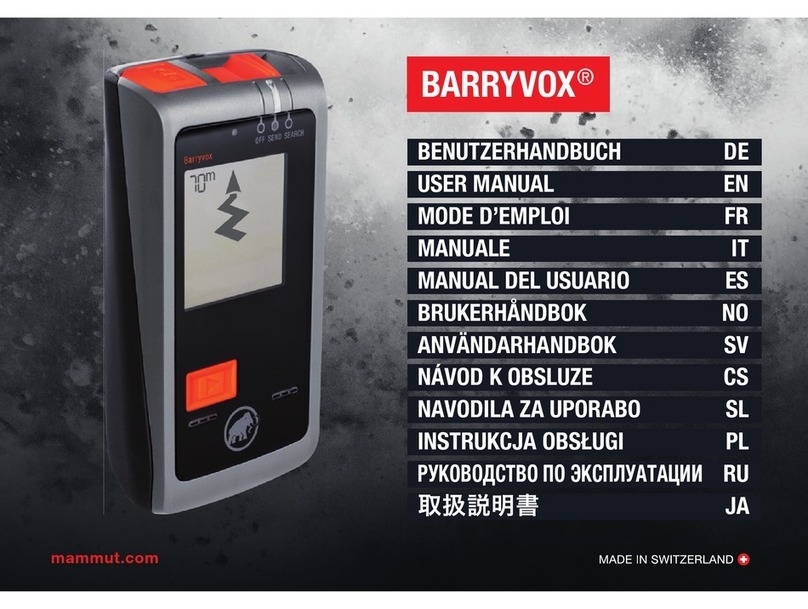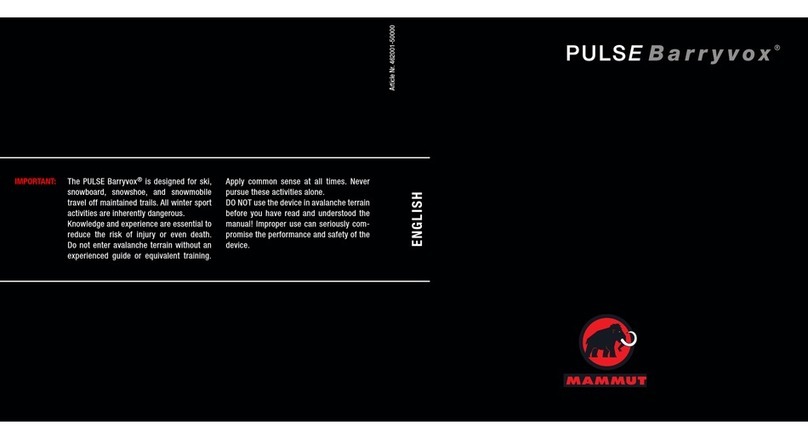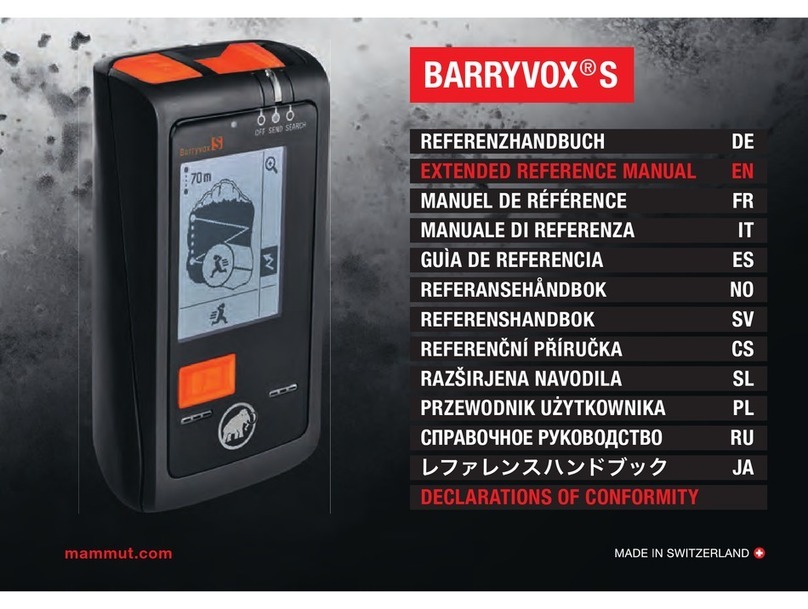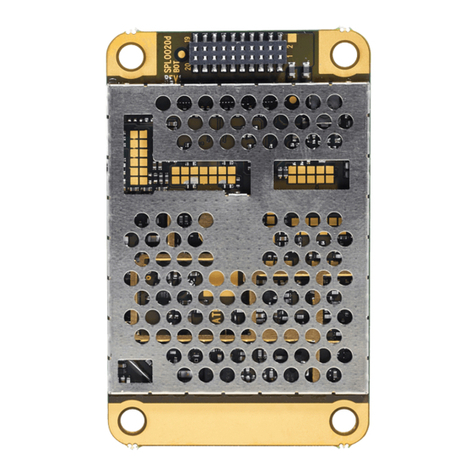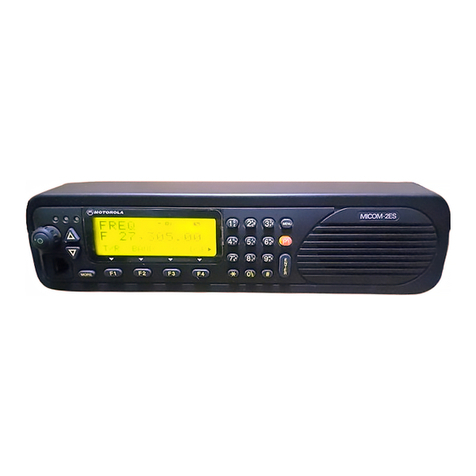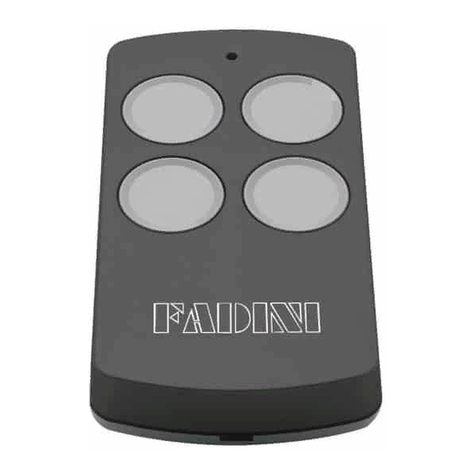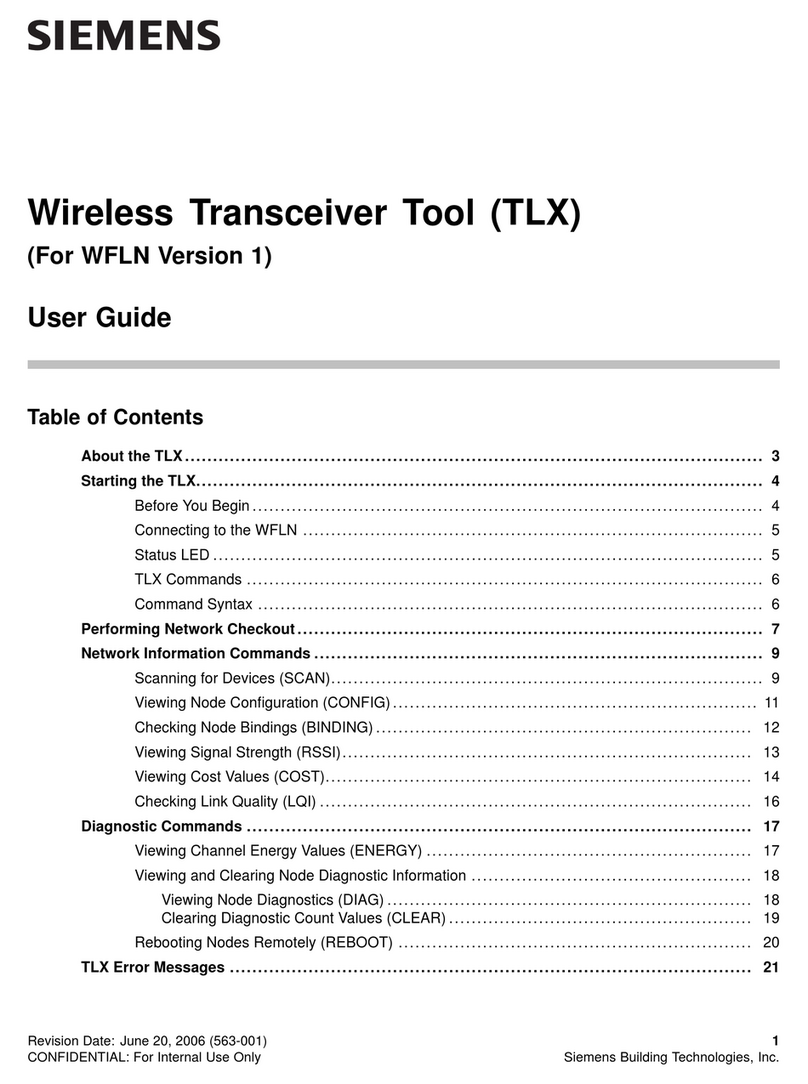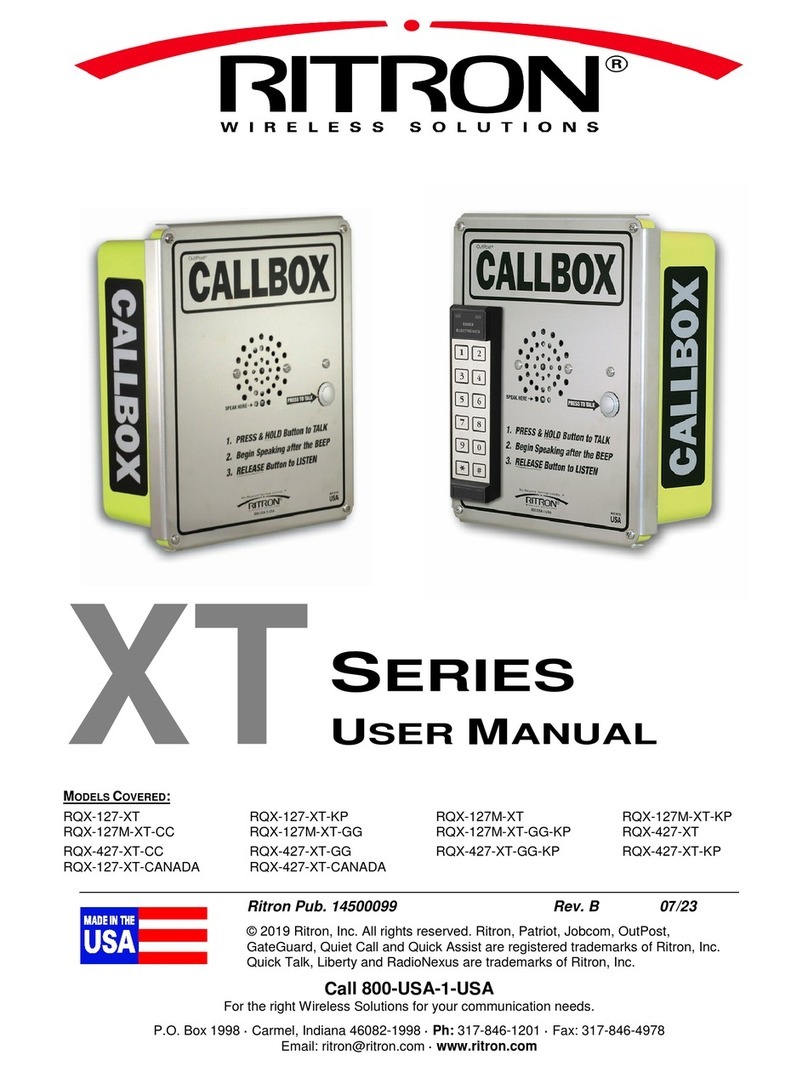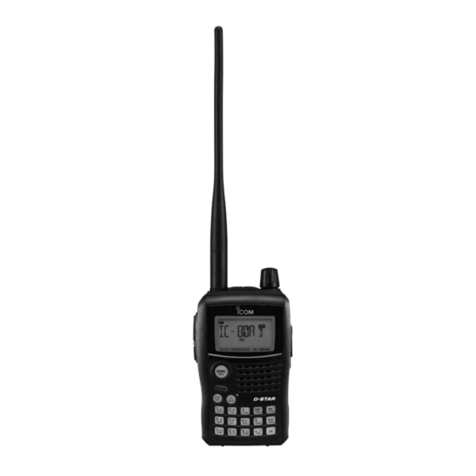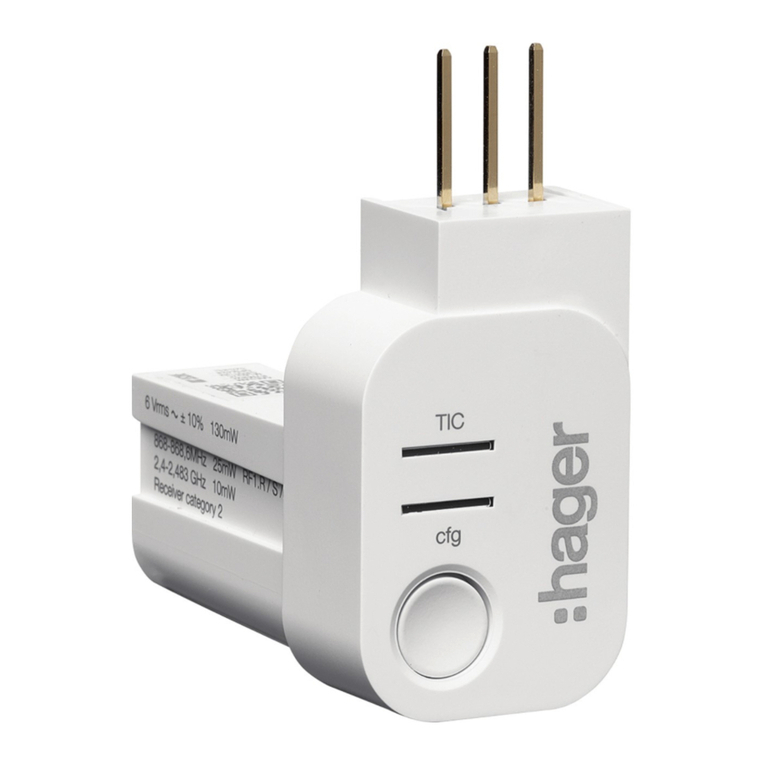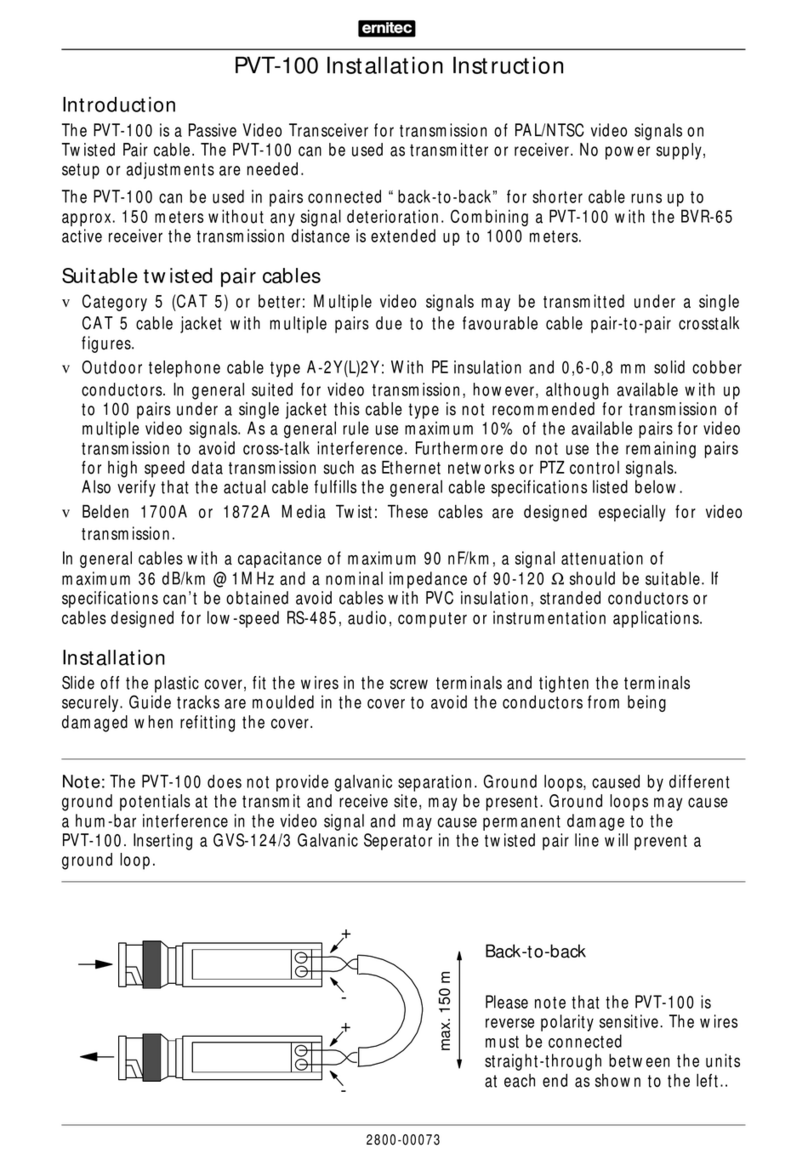Mammut BARRYVOX User manual

mammut.com
BARRYVOX®
REFERENZHANDBUCH DE
EXTENDED REFERENCE MANUAL EN
MANUEL DE RÉFÉRENCE FR
MANUALE DI REFERENZA IT
GUÌA DE REFERENCIA ES
REFERANSEHÅNDBOK
NO
REFERENSHANDBOK
SV
REFERENČNÍ PŘÍRUČKA
CS
RAZŠIRJENA NAVODILA SL
PRZEWODNIK UŻYTKOWNIKA PL
СПРАВОЧНОЕ РУКОВОДСТВО
RU
レファレンス ハンドブック
JA
DECLARATIONS OF CONFORMITY

North America:
Mammut Sports Group Inc.
458 Hurricane Lane
Williston, US-VT05495
Phone +1 800 451 5127
Europe:
Mammut Sports Group GmbH
Mammut Basecamp 1
DE-87787 Wolfertschwenden
Phone +49 (0)8334 3620 0
Switzerland (Head Oce):
Mammut Sports Group AG
Birren 5
CH-5703 Seon
Phone +41 (0)62 769 81 81
mammut.com BARRYVOX®

EXTENDED REFERENCE GUIDE
BARRYVOX®3
EXTENDED REFERENCE GUIDE
BARRYVOX®
HANDLING THE BARRYVOX®.............5
INITIAL SETUP ........................6
CARRYING POSITIONS ..................8
COCKPIT – OVERVIEW OF FUNCTIONS .....10
GROUP CHECK .......................12
SEND ..............................15
SEARCH ............................16
ADDITIONAL INFORMATION .............29
COMPANION RESCUE ..................33
DECLARATIONS OF CONFORMITY .........37
mammut.com

EXTENDED REFERENCE GUIDE
BARRYVOX®4
Congratulations on the purchase of your new Barryvox®.
This user manual explains the functionality and use of the
Barryvox®. The Barryvox®is a revolutionary, sensor-controlled
avalanche transceiver, which is very easy to use. Additional
detailed information and advanced instruction may be found in
the Barryvox®Extended Reference Guide.
Register your Barryvox®and get a 3 year warranty
extension!
Register your Barryvox®today at www.Barryvox.com, to get
important information such as announcements about the
availability of software updates.
After a successful registration your device is covered for 5
years by warranty.
Barryvox®Transceivers – Made in Switzerland
Our heritage is compelling. Mammut and Barryvox®follow the
time-honored tradition of world-class precision products made
in Switzerland. From its design to its engineering and produc-
tion, this device is completely made in Switzerland.
This device is compatible with all avalanche transceivers
that comply with the EN 300718 standard and operate on a
frequency of 457 kHz.
The following documents for the Barryvox®transceivers are
available at www.mammut.com/BarryvoxManual:
Barryvox®User Manual
The Barryvox®User Manual describes the SEND and group
check functions as well as the standard search mode. In addi-
tion, you will find all information regarding basic maintenance,
warranty and repair as well as the technical specifications.
Barryvox®Extended Reference Guide
This Extended Reference Guide is a comprehensive resource of
information for your Barryvox®. It includes additional informa-
tion that augments the user manual concerning device settings,
advanced search and rescue techniques, and in particular the
alternate search mode. It is an important and valuable resource
for advanced recreational and professional users – and all
educators.
Approval / Conformity
All information concerning approval and conformity is available
at the very end of this booklet.

EXTENDED REFERENCE GUIDE
BARRYVOX®5
HANDLING THE BARRYVOX®
Like all transceivers, the Barryvox®contains shock sensitive
ferrite antennas. Therefore, you should handle it with utmost
care!
Store the device and the carrying system in a dry spot that is
protected from extreme cold or heat and direct sunshine.
Always check the result of the self- and battery test, pay atten-
tion to alert messages and carry out the group check.
It is your responsibility to frequently check your Barryvox®for
mechanical damage of the casing, proper function of the main
switch, battery compartment cover as well as cleanliness and
mechanical integrity of the battery contacts.
To ensure the proper performance of the transceiver, it is
highly recommended that you send your device to an ocial
Barryvox®service center once every three years for a functional
test. The recommended date of the next check can be viewed
under «Maintenance» in the shut down sequence of the device.
(see chapter «Periodic Checks» of the Barryvox®S Extended
Reference Manual).
Interferences
Always avoid having other electronic devices (e.g. mobile
phones, radios, headlamps, cameras), metal objects (pocket
knives, magnetic buttons), or other transceivers close to
(20 cm in SEND; 50 cm in SEARCH) your running avalanche
transceiver.
You should not wear clothing with magnetic buttons! Users of
pacemakers are advised to carry the device in a secure pants
pocket (no vital data detection). Consult the manufacturer’s
instructions with regard to the impact on pacemakers.
When searching, hold the device at a minimum of 50cm
away from these objects and turn o any electronic
devices, if possible. It is highly recommended to turn OFF
mobile phones!
HANDLING THE BARRYVOX®

EXTENDED REFERENCE GUIDE
BARRYVOX®6
INITIAL SETUP
Batteries
Only use alkaline (LR03/AAA) batteries of the same type.
Always insert 3 new batteries of the same type. In case these
batteries need to be removed, the same 3 batteries or 3 new
batteries must be reinserted. Never use rechargeable batteries
and always replace all the batteries at the same time.
Make sure the lid is properly closed and that the device and the
batteries stay dry.
Use a fingernail or the leash clip to slide battery door to the left,
and it will swing open.
2
1
2
1
Periodically inspect the battery compartment. Clean or dry it, if
needed, since moisture can cause corrosion.
Avoid touching the contacts with your hands, use a clean cloth.
A reliable power supply is crucial for safe operation.
When storing or not using the transceiver for an extended
period of time (summer, travelling, shipping), remove bat-
teries. The warranty becomes void if batteries have leaked!
INITIAL SETUP

EXTENDED REFERENCE GUIDE
BARRYVOX®7
INITIAL SETUP
Main Switch OFF / SEND / SEARCH
The main switch is located on the top side of the device. In the
left position OFF, the device is turned o, in the center position
SEND the device is in SEND mode and in the right position
SEARCH, the device is in SEARCH mode. For safety reasons, it
is required to press the hinged unlock button to leave the SEND
mode. To return from SEARCH to SEND, simply push the main
switch sideways.
Always make sure that the switch locks into position mechani-
cally to avoid an undesired change of mode.
User Interface and Use of Buttons
The use of the Barryvox®is easy and straightforward. All user
interaction is done with the button on the front side. To
confirm your selection, use the orange button. The action
triggered by pressing the button is shown at the bottom
left of the screen.
Samples:
Press the button to…
…activate the group check.
SEARCH –>SEND SEND –>OFF
OFF –>SEND SEND –>SEARCH

EXTENDED REFERENCE GUIDE
BARRYVOX®8
CARRYING POSITIONS
BarryLeash
Attach the BarryLeash to the bottom of the device.
1
1
1
1. 2. 3.
Adjust the BarryMount to fit your body. Regardless of the carry-
ing position, the display should always face your body!
The detection of vital data is only possible if you carry the
device in the BarryMount.
CARRYING POSITIONS

EXTENDED REFERENCE GUIDE
BARRYVOX®9
CARRYING POSITIONS
Carrying the Transceiver in a Pocket
If you carry the Barryvox®in a pants pocket, the zipper must
remain closed for the duration of the trip. Always use a secured
pocket (see illustration). The wrist loop should be secured to
your pants or around your belt.
BarryMount (Recommended Carrying Position)
The BarryMount should be put on over your innermost layer of
clothing prior to beginning the trip (see illustration) and must be
worn on your body for the duration of the trip. The transceiver
must always remain covered by one layer of clothing. The
device itself is inserted into the BarryMount according to the
illustration. It should always remain attached to the holster
using the clip of the BarryLeash.

EXTENDED REFERENCE GUIDE
BARRYVOX®10
COCKPIT - OVERVIEW OF FUNCTIONS
COCKPIT – OVERVIEW OF FUNCTIONS
Turning the Device ON and OFF
Firmware Version (Barry Brain)
Group Check: enter group
check by pressing the key.
The device shuts down 2
seconds after the main switch
has been moved to the OFF
position.
Press the key to access
device and maintenance info.
W-Link Region (see chapter
«Additional Information»)
Year of the next periodic check
(see chapter «Handling the
Barryvox»)

EXTENDED REFERENCE GUIDE
BARRYVOX®11
COCKPIT - OVERVIEW OF FUNCTIONS
Group Check
Participant
Leader
Status information or
instructions for the leader.
Exit Group check and enter
SEND mode by pressing the
key
SEND
Remaining battery
percentage
The device is currently
in SEND mode
SEND mode status:
Self test status information.
Alert messages.
(Status information disappears
after 10sec in SEND mode)
SEND mode functions
properly.
Alert:
the SEND function
is compromised and
transmits with reduced
power.

EXTENDED REFERENCE GUIDE
BARRYVOX®12
GROUP CHECK
GROUP CHECK
1 m
3 m
Single Group Check
Before a party takes off, the transceivers of all party members
must be checked. The participants switch their device to SEND
mode.
The group leader activates the group check by switching his
device from OFF to SEND and presses the button within
the first seconds.
Participant –>SEND
Leader –>Group Check

EXTENDED REFERENCE GUIDE
BARRYVOX®13
GROUP CHECK
The test is successful if you can clearly hear beep sounds from each participant‘s transceiver
within the range indicated on the display.
The members of the party must be spread out appropriately to avoid mutual interference.
The indicated test distance must not be shortened, or the group check becomes very unreliable.
Once all the participant‘s devices are tested, the group check is concluded. The group leader’s
transceiver must be switched to the SEND mode.
If no tone is heard within the indicated range, the device must not be used.
Further procedure: 1. Check if the device is switched to SEND.
2. Replace the batteries.
3. Have the device checked by the manufacturer.
Chapter «Maintenance and Repair».
If your Barryvox®detects that the transmit frequency of the tested device is out of tolerance, a
warning message will be shown. In this case, repeat the test with 5m distance between the par-
ticipants to identify the defective transmitter. Such devices must be checked by the manufacturer.

EXTENDED REFERENCE GUIDE
BARRYVOX®14
GROUP CHECK
1 m
3 m 3 m
1 m
Double Group Check
We recommend to perform a double group check once a
week and in general when a new group gets together. The
double group check individually tests the SEND and SEARCH
function of all devices. The members of the party activate the
group check on their transceivers or set them to a low receive
volume. The leader switches his or her transceiver to the
SEND mode and ensures that all party members can receive.
Subsequently, the party members switch their transceivers to
SEND, and the leader activates the group check or sets the
transceiver to a low receive volume. The SEND mode of all
transceivers is checked, and ultimately the leader switches his
or her transceiver to SEND.
Participants
Leader

EXTENDED REFERENCE GUIDE
BARRYVOX®15
SEND
SEND
The SEND mode is the normal operating mode outdoors or in
all other situations in which there is a risk of avalanches.
Each time the SEND mode is activated, this is
confirmed by an ascending triple beep sound.
Each individual signal pulse is tested. If the
test is successful, this is confirmed by a blink
of the red SEND-Control LED.
If the device detects that the SEND function
is compromised, the red SEND-Control LED
stops flashing and screen shows an alert
message.
To save battery power, the LCD screen is automatically deac-
tivated in the SEND mode, but can be activated any time by
pressing the button.

EXTENDED REFERENCE GUIDE
BARRYVOX®16
SEARCH
Although the avalanche transceiver is easy to use, its eective
use requires proper training. We recommend that you practice
transceiver searches regularly.
Be aware that electronic devices including mobile phones used
by other rescuers may disturb the search. Therefore it is highly
recommended to switch o phones which are not absolutely
required!
At the beginning and during the search, pay close attention
that the rescuer’s transceivers are not transmitting and do
not switch to SEND unintentionally. It does not make sense to
remove your backpack and assemble the shovel and probe at
the edge of the avalanche debris. Keep your backpack with all
the equipment on you! The assembled shovel and probe is only
a hindrance during signal and course search. Only remove your
pack to assemble probe and shovel once you have successfully
concluded the fine search.
SEARCH
Elementary understanding of transceiver search
The 457kHz transmitter of the transceiver has a kidney shaped
transmit distribution, which is visualized with field lines in the
illustration below. The searching transceiver’s arrow leads the
rescuer along the field lines and therefore usually in a curved
line to the buried subject.
Search Along the Field Line: Flux Line Search

EXTENDED REFERENCE GUIDE
BARRYVOX®17
SEARCH
Search Phases
In an avalanche search, the following phases are distinguished:
1
2
3
4
Signal search
Search area to the point where the
first clearly audible signal can be
detected.
Coarse search
Search area starting from the
reception of the first signal until
the immediate vicinity of the buried
subject. In this phase the signal
search pattern is abandoned in
order to follow the signals leading
to the buried subject.
Fine search
Search area in the immediate vicin-
ity of the buried subject.
Pinpointing
First use of the probe until probe
hit.
using
transceiver
using probe

EXTENDED REFERENCE GUIDE
BARRYVOX®18
SEARCH
1 2 3 4
SIGNAL SEARCH COARSE SEARCH <10 FINE SEARCH PINPOINTING

EXTENDED REFERENCE GUIDE
BARRYVOX®19
SEARCH
Signal Search
BarryTip: Move swiftly.
Emergency plan, search strategies and
search strip widths: please see back
side of device.
Search avalanche surface systemati-
cally.
During signal search, the rescuer has
his visual focus on the surface of the
debris in order to look for visual clues
on the snow surface. The first signal
is indicated by a distinct double beep
sound.
1
From the start of the search until you clearly hear the first tone,
you are in signal search.
The avalanche surface is searched systematically until you pick
up a signal. During the acoustic signal search, the rescuer has
the visual focus on the surface of the debris in order to be able
to see body parts or objects protruding the snow surface.

EXTENDED REFERENCE GUIDE
BARRYVOX®20
SEARCH
If your Barryvox®detects that the signal search strip width
needs to be reduced due to interference or due to a device
transmitting outside the standard frequency, the reduced
search strip width will be indicated.
Reduced signal search strip
width due to interference.
Reduced signal search strip width due
to a device transmitting outside the
standard frequency.
Other manuals for BARRYVOX
3
Table of contents
Other Mammut Transceiver manuals
Popular Transceiver manuals by other brands

Kenwood
Kenwood TH-21A instruction manual
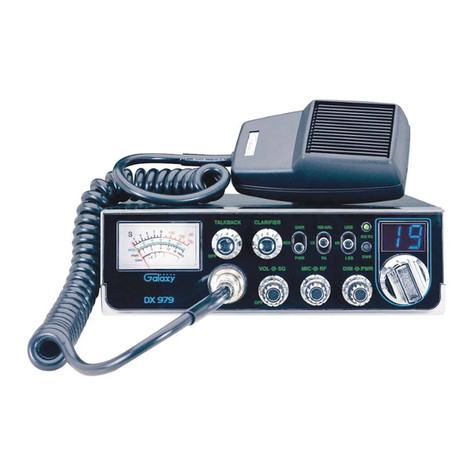
Galaxy
Galaxy DX 979 owner's manual
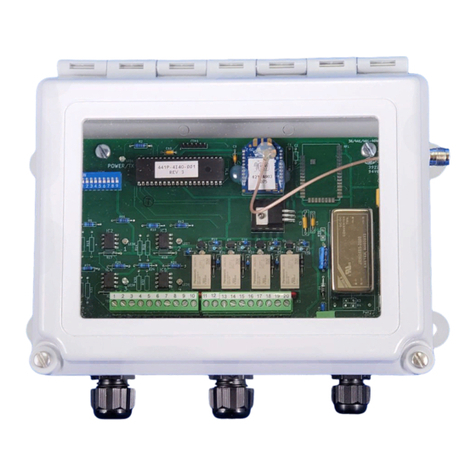
BWI Eagle
BWI Eagle AIR-EAGLE SR PLUS Product information bulletin

Yaesu
Yaesu FTM-300DR operating manual

Yaesu
Yaesu FV-901DM instruction manual
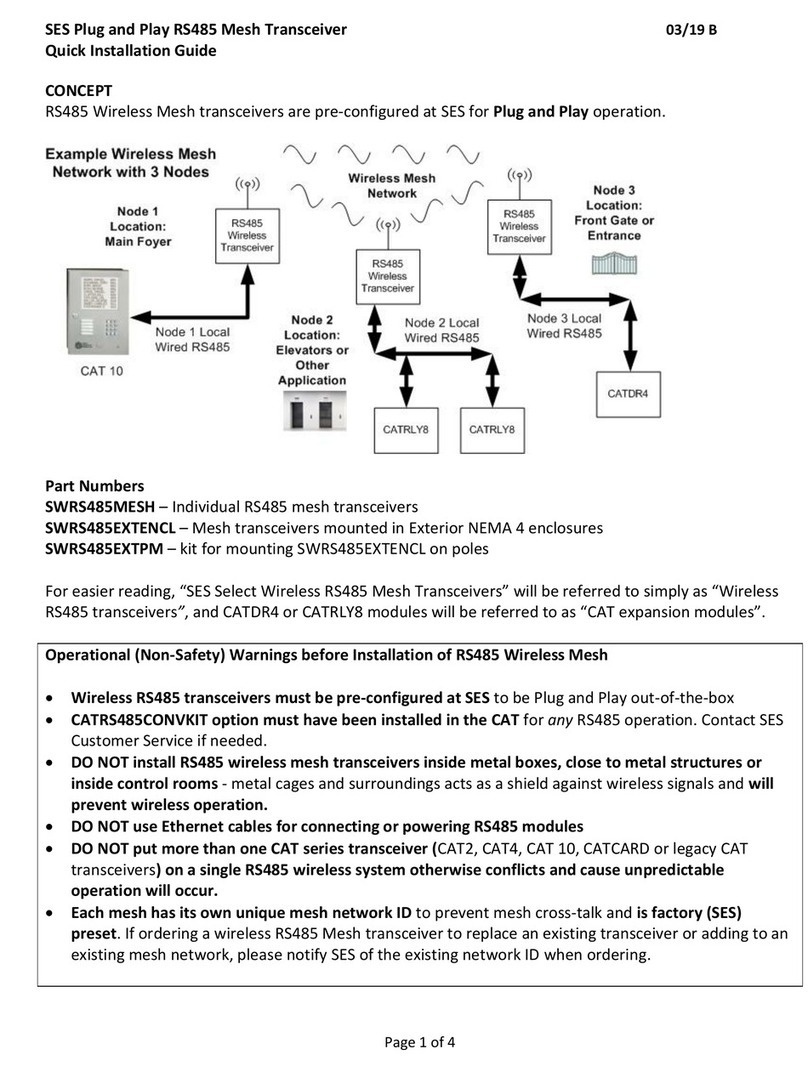
Select Engineered Systems
Select Engineered Systems SWRS485MESH Quick installation guide
